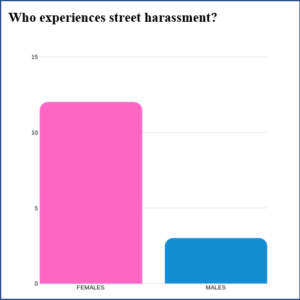According to survey, females experience more harassment downtown than males
By Kamryn Cusumano
April 22, 2019
As spring approaches, Windsor’s downtown will begin to bustle with pedestrians enjoying the warmer temperatures – with the increase in downtown activity also comes an increase in street harassment.
An unscientific survey conducted by the MediaPlex found that more females are subjected to sexually harassing remarks as they walk the streets of downtown Windsor, compared with males. According to the survey, females also feel less comfortable walking downtown alone. The results indicate significant gender differences in how males and females experience public spaces downtown.
The survey selected 15 females and 15 males, ages 18 and above.
According to the survey, 70 per cent of females said they have experienced harassment compared with 10 per cent of males.
Street harassment was defined for the resp
ondents as: “A form of harassment that consists of unwanted comments, gestures, honking, wolf-whistling, catcalling, exposure, following, persistent sexual advances and touching of strangers in public areas such as streets, shopping malls and public transportation.”
The survey results indicate that females report having experienced sexually harassing remarks, whereas most males reported they have never experienced this.
The majority of female respondents said they usually experience harassment while in public spaces downtown. Most males said they rarely or never experienced this.
According to the survey, most of these unwanted remarks or gestures came from men. Males and females agreed the perpetrators of street harassment were “men” or “mostly men.”
“I never experienced sexual harassment,” said Michael J. Krym, 30, a male survey respondent. “I rarely experience street harassment but the occurrences I have are almost never sexual in nature.”
He said he notices most of the harassment coming from men. Krym works at Starbucks downtown and said he has witnessed female co-workers being harassed by men but it was in passing so nothing was done to address it.
Amy Weiz, 28, a female survey respondent, said she experiences street harassment and said downtown on Saturday nights is the worst when it comes to harassment.
“Most of the touching has happened in bars,” said Weiz. “[street harassment] happens more when I’m with a group of women. I feel it’s usually a group of guys.”
Weiz said all of the harassment she has experienced has been from men and said all of the remarks are always sexual in nature.
According to Hollaback, an anti-street harassment advocacy group, sexual violence exists on a spectrum. Mild verbal harassment sits on one end and sexual assault and rape sit on the other. Harassment carries many of the same traits as other forms of sexual violence and can cause considerable mental and emotional damage.
According to the survey, more males feel comfortable walking the streets of downtown than females. The survey found 80 per cent of males said they feel very comfortable walking through downtown alone during the day compared with 27 per cent of females. Females most commonly said they felt “comfortable” walking alone during the day.
Males responded that during the evening they were still “very comfortable” walking around whereas females most commonly answered “sometimes comfortable.” Only females responded that they were “uncomfortable” and “very uncomfortable” when walking alone in the evenings.
Weiz said she walks downtown only a couple of times a month. She said she feels uncomfortable walking alone during the daytime and very uncomfortable walking downtown in the evening. She said her small stature and the increase in crime downtown has her worried.
Krym said he always walks downtown and feels comfortable during the day and sometimes comfortable at nighttime. He said his biggest concern for his safety is from the emptiness of downtown and people on drugs.
According to Hollaback, street harassment happens in every country in the world. Therefore, it is not a cultural phenomenon. According to their website: “Harassment is deeper than the colour of our skin or the income brackets of our neighbourhoods.”
The Hollaback website states that street harassment is pervasive in areas where gender-based violence is the norm and street harassment is not about sex, but power.
Lauren Malcolm said a recent encounter with a man on the street has left her feeling uncomfortable to walk home alone.
“I think I’ve experienced men cat-calling lots of times but never felt unsafe, just annoyed,” said Malcolm. “Until last summer, walking home from work one night I had a guy run at me from across the street asking me for money, following behind me. I think that was the first time I felt threatened.”
Hollaback has 16 countries participating in this global movement to end harassment. The closest chapter to Windsor is in Toronto.
According to their website, their mission is to build safe, inclusive public spaces by transforming the culture that perpetuates discrimination and violence. Their organization offers training programs, online workshops and an online forum where people can submit their stories of harassment.
Windsor has yet to adopt any street
harassment initiative to make public spaces more inclusive to all genders and other vulnerable groups.

70 per cent of females respondents said they have experienced street harassment compared with 10 per cent of male respondents.


